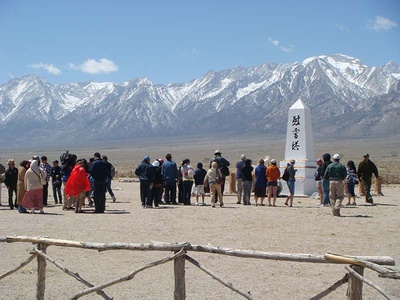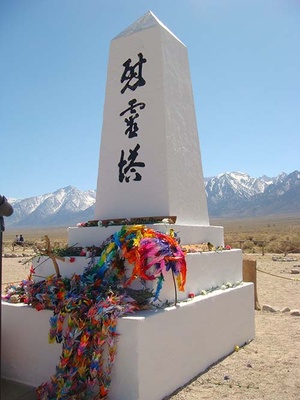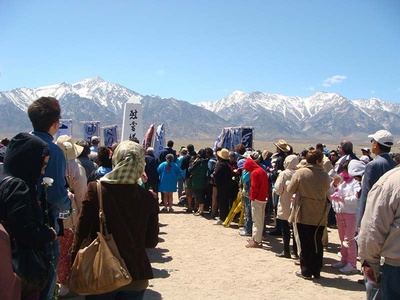On a sunny cold day in April, I boarded a bus in Little Tokyo, one of more than 1,500 people to make the 40th annual Manzanar pilgrimage. Our destination was the remote Owens Valley World War II prison camp where my father and his family were placed behind barbed wire in April 1942.
Manzanar was one of ten euphemistically named “internment” camps authorized by President Franklin D. Roosevelt following the December 1941 bombing of Pearl Harbor. The nearly 120,000 Japanese American citizens and legal residents of Japanese descent imprisoned in those camps until war’s end were victims of war hysteria and naked racism. Amid fears of Japanese saboteurs lurking among the immigrant community, U.S. military leaders asserted the camps were a “military necessity.”

Young, old Buddhist, Christian and Muslim pilgrims gathered at Manzanar cemetary for the 40th annual Manzanar Pilgrimage.
In fact, not a single case of sabotage by a Japanese resident alien or a Japanese-American citizen was documented during the war. Instead, the 4,000-troop all-Japanese-American 442nd Regimental Combat Team became the most decorated unit of the war, losing nearly a quarter of its ranks in battle.
As the Los Angeles sprawl receded behind us, rolling green hills gave way to the arid brown Antelope Valley, where Joshua trees and wind turbines dotted the lonely landscape. I imagined my father as a 13-year-old, the same age my son is now, making this 230-mile trip, not in a luxury tour bus, but squeezed into a fetid 1940s model, its black-out shades pulled down tight. My father would have been dressed in his best clothes, wondering where he was headed, perhaps fearing being bayoneted or shot at the end of the line.
Gradually, the crystal clear snow-covered peaks of the Sierra Nevada began to appear to our left, an Ansel Adams photograph come to life. At the camp cemetery, marked by a tall ireito, or memorial obelisk, Justice Department Regional Director Ron Wakabayashi stood on a makeshift stage and recalled being a Nisei schoolboy during those traumatic days before internment. Some kids quit school to avoid being shunned by classmates, or called up in front of the class to hear, “This is what the enemy looks like.”
The pilgrimages did not begin until 1969, after the civil rights, Black power and women’s movements began to open the door to minority rights. Until then, the sense of shame, humiliation and internalized guilt of internment was still too raw to allow for discussion. In 1988 President Ronald Regan issued an apology and a $20,000 payment to each surviving internee, and in 1992, the National Parks Service established the Manzanar National Historic Site.
After 9/11, the illegal detainment of non-U.S. citizens at Guantanamo Bay, the harassment of Muslims living in America, and more recently, damning Justice Department memos on abusive interrogation techniques and torture during the Bush Administration, the pilgrimage assumed new relevance. For Japanese Americans of a certain age, this latest era of race hatred and disposable civil rights is déjà vu all over again. The prominence of Muslim hijab headscarves and the large number of college groups at the pilgrimage lent the proceedings an air of both urgency and energy.
Bruce Embrey, co-chair of the Manzanar Committee, told the gathered crowd, “Every year since nine-eleven, we come to the site with new faces, we hear new prayers offered, and we hear another community speak the same words our grandparents and our fathers and mothers spoke: ‘We are not enemy aliens, we are not traitors. We are not spies and we are not terrorists.’ We come here with one simple demand: Never again.”
Current affairs crackled in the bracing high desert air, but so did a piece of unfinished business from the past. A group called Campaign for Justice publicized its efforts to redress the pain and suffering of 2,264 Latin Americans of Japanese ancestry who were abducted and forcibly relocated to Texas’s Crystal City internment camp during the war. More than 800 of these prisoners were used as hostages in exchange for American POWs held in Japan; the rest were detained until the end of the war without due process, then forced to leave the country. Fewer than 200 were allowed to return to their Latin American homes and more than 900 were deported to war-wasted Japan. Pending House and Senate bills (H.R. 42, S. 69) would establish a federal commission to study these wartime violations and recommend appropriate remedies.
As the cry of “never again” rang out across the desert, I thought of my father and understood. As Sansei and Yonsei we are far removed from the events of World War II, yet the DNA of obligation and filial piety still runs deep in our blood. Fighting for redress for the last Latin American Japanese internee is about wanting to see justice prevail. But it is also about honoring and thanking the Issei and Nisei who endured and suffered on our behalf.

At Manzanar cemetary, the crowd lay flowers, strings of origami cranes, and other tokens at the base of the Ireito memorial.
© 2009 Nancy Matsumoto







